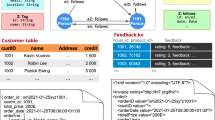Abstract
We introduce the notion of metadata and the role it plays in a user's understanding of data in a database. We survey the kinds of metadata present in database schemas through an Abstract Conceptual Schema, and also the kinds of metadata associated with frames in knowledge engineering tools. Finally we look at networks used for natural language understanding, (KL-ONE and MEMORY), and describe a metadata knowledge representation (MAKR) which relates database metadata to a KL-ONE style meaning representation. Examples in MARK are used to illustrate the kinds of metadata surveyed in the first part of the paper.
Similar content being viewed by others
References
Alshawi, H. (1984) Memory and Context for Language Interpretation Cambridge University Press, Cambridge, UK.
Atkinson, M. P. & Kulkarni, K. G. (1984) Experimenting with the functional data model. In Databases-Role and Structure (eds P. M.Stocker et al.) pp. 311–338, Cambridge University Press, Cambridge, UK.
Boguraev, B. K., Copestake, A. A. & Sparck-Jones, K. (1986) Inference in natural language front ends. IFIP WG. Conference on Knowledge and Data (Algarve) (eds R.Meersman & J.Sowa) Amsterdam, North-Holland.
Borkin, S. A. (1980) The semantic relational data model: foundation for a user interface. Proceedings of the International Conference on Databases (Aberdeen) pp. 47–64. (eds S. M.Deen & P.Hammersley) Heyden, London, UK.
Brachman, R. J. (1985) I lied about the trees, or Defaults and Definitions in Knowledge Representation. AI Magazine, 6, 80–93.
Brachman, R. J., Gilbert, V. P. & Levesque, H. J. (1985) An essential hybrid reasoning system: knowledge and symbol level accounts of Krypton. Proceedings of the IJCAI 1985 (Los Angeles).
Brachman, R. J. & Schmolze, J. G., (1985) An overview of the KL-ONE knowledge representation system. Cognitive Science, 9, 171–217.
Carnegie Group (1985) Knowledge Craft 3–0 Reference Manual, Carnegie Group Inc., Station Square, Pittsburgh, PA, USA.
Fahlman, S. E. (1979) NETL: A System for Representing and Using Real-World Knowledge MIT Press, Cambridge MA, USA.
Fox, M. S., Wright, J. M. & Adam, D. (1984) Experiences with SRL: an analysis of frame-based knowledge representations. In Expert Database Systems (ed. L. Kerschberg).
Gray, P. M. D. (1984) Logic, Algebra and Databases Ellis Horwood, Chichester, UK.
Gray, P. M. D., Moffat, D. S. & du Boulay, J. B. H. (1985) Persistent Prolog: a secondary storage manager for prolog. In Persistence and Data Types. (eds M. P. Atkinson, P. Buneman & R. Morrison) Glasgow University Persistent Programming Research Report.
Moffat, D. S. & Gray, P. M. D. (1986) Interfacing Prolog to a persistent data store. Proceedings of the 3rd International Conference on Logic Programming (London), (ed. E.Shapiro), Springer-Verlag, Berlin.
Mylopoulos, J. & Levesque, H. J. (1984) An overview of knowledge representation. In On Conceptual Modelling (eds M. L.Brodie, J.Mylopoulos & J. W.Schmidt) pp. 3–17. Springer-Verlag, Berlin.
Quillian, M. R. (1968) Semantic Memory. In Semantic Information Processing (ed. M. L.Minsky) pp. 227–270 MIT Press, Cambridge MA, USA.
Shipman, D. (1979) The functional data model and the data language DAPLEX. In Proceedings of the ACM SIGMOD79 Conference (Boston), revised and printed in ACM TODS, 6, 140–173.
Smith, R. G. (1983) STROBE: support for structured object knowledge representation. Proceedings of the IJCAI 1983, (ed. A. Bundy) pp. 855–858. Morgan Kaufmann.
Sowa, J. F. (1984) Conceptual Structures: Information Processing in Mind and Machine Addison-Wesley.
Stocker, P. M. & Cantie, R. (1983) A target-logical schema: the ACS. In Proceedings of the VLDB 1983 (Florence).
Storrs, G., du Boulay, J. B. H. & Gray, P. M. D. (1985a) A metadata advisor: some sample queries. Department of Computing Science Research Report. University of Aberdeen.
Storrs, G. E., du Boulay, J. B. H. & Gray, P. M. D. (1985b) Representing knowledge in the metadata advisor. In Proceedings of the ARTINT Workshop on AI and Information Retrieval (Luxembourg), CEC.
Tomlinson, A. M. (1985) Users and the visual interface system. Unpublished MSc thesis, University of Manchester.
Webber, B. L. & Mays, E. (1983) Varieties of user misconceptions: detection and correction. In Proceedings of the IJCAI 1983 (Karlsruhe) pp. 650–652. (ed. A. Bundy).
Author information
Authors and Affiliations
Rights and permissions
About this article
Cite this article
Gray, P.M.D., Storrs, G.E. & du Boulay, J.B.H. Knowledge representations for database metadata. Artif Intell Rev 2, 3–29 (1988). https://doi.org/10.1007/BF00139623
Issue Date:
DOI: https://doi.org/10.1007/BF00139623




